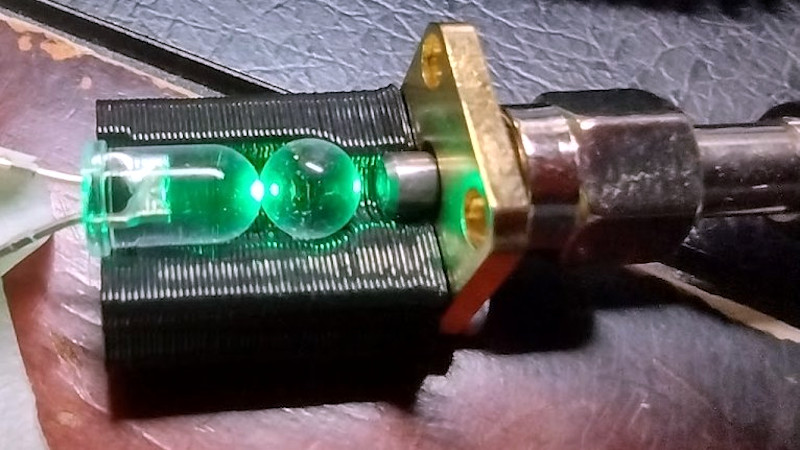It’s fair to say that for most of us, using a fiber optic cable for digital audio or maybe networking will involve the use of an off-the-shelf termination. We snap the cable into the receptacle, and off we go. We know that inside there will be an LED and some lenses, but that’s it. [TedYapo] though has gone a little further into the realm of fibers, by building his own termination. Faced with the relatively high cost of the ball lenses used to focus light from an LED into the end of the fiber he started looking outside the box. He discovered that spherical glass anti-bumping balls used when boiling fluids in laboratories make an acceptable and much cheaper alternative.
A ball lens has an extremely short focal length, meaning that this same property which allowed Antonie van Leeuwenhoek to use them in his microscopes is ideal for LED focusing in a small space at the end of a fiber. Chromatic aberrations are of no consequence for light of a single wavelength. It seems that the glass balls are uniformly spherical enough to do the job. Fitted with the LED and fiber termination in a 3D-printed block, the relative position of the ball can be controlled for optimum light transfer. It’s a relatively simple hack mentioned in passing in a Twitter thread, but we like it because of its cheapness and also for an insight into the world of optical fiber termination.
Curious to know more about optical fibers? We covered just the video for you back in 2011.
















Another good source pf a ball lems is the little ball that seals fountain pen ink cartridges. They are often glass and much rounder than silica gel balls, all be it less common these days. They make pretty good microscopes. The original glass bead microscopes were often made by sandwiching aa small ball of glass between two sheets of metal, but you had to contend with the extremely short focal length, as the price to pay for extremely high magnification.
I thought about those marbles that are placed in the paint of road markings to make them reflective, too
We used to ‘collect’ these in the old days, but arent these sanded mat?
I’ve seen both versions tbh…
Yeah Ive only seen them being frosted
I’ve not placed an order, but this company might be worth looking into, they seem to have a good selection.
https://www.glass-sphere.com/en/eshop/kristalove-kulicky-optik.html
For anyone wondering, the difference in price getting a precision lens versus a “it works for this” lens. The “$31 spherical lens” are far closer to being perfect spheres and their optical qualities (e.g. wavelength) are exacting. For this application, you just need something close to a sphere that will allow enough of the wavelength used to pass through.
If you work in a laser lab then you are going to stick to the expensive optics because having an lens melt or explode can ruin other equipment and hurt people.
Those are often a cylinder with a rounded end.
They might be good for a reflection end terminator, for testing the length and losses ect.
Many “pump packs” have a small glass bead as part of the one way valve mechanism.
I wonder if you could polish bead-blast glass beads in a rock tumbler with fine polish?
Glass ball bearings are also inexpensive and much better spheres. There are also sapphire and other bearings that can be used as high precision ball lenses.
https://www.dollartree.com/en/round-glass-floral-marbles-14oz-bags/169540
Some stores still have them for $1.
Ball lenses [1] (not to be confused with Spherical Lenses [2] which have spherically ground surfaces but are typically not spherically shaped overall) have a uniform refractive index. Reference [1] shows the general equations for a ball lens in addition to the special case of using a ball lens for laser to fiber coupling. A ball lens with a gradient refractive index is called a Lüneburg lens [3] which has interesting uses but is typically difficult (hence costly) to manufacture.
1. Understanding Ball Lenses w/Laser to Fiber Coupling
https://www.edmundoptics.com/knowledge-center/application-notes/optics/understanding-ball-lenses/
2. Spherical Lenses
https://physics.info/lenses/
3. Lüneburg Lens
https://en.wikipedia.org/wiki/Luneburg_lens
Fiber optic numerical aperture is much smaller than the incident angle from the ball lens. Most of the light will not ttansmit to the fiber. Waste of time and money…
Isn’t the top of a through hole LED already a half-sphere lense? Is the final length too short? Or is the manufacturing just not right enough for this purpose? Or do you need that front face for the retraction to go the right direction?
D-Nail has ‘high’ quality quartz products such as a 4.7mm sphere: https://d-nail.com/d-nail-quartz-comet/
This is normally used for dabbing, and costs $10 plus shipping.